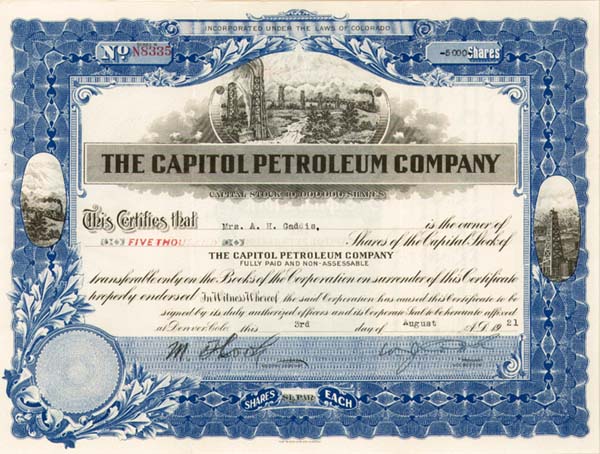
The modern American petroleum industry truly began at the beginning of the 20th century. The Capitol Petroleum Company wanted to be part of it, but failed.
Although the first commercial U.S. oil discovery had taken place in 1859 in Pennsylvania (for making kerosene), demand for another refined product would create thousands of new companies. They searched for “black gold.”
In Texas, an 1894 discovery of the Corsicana oilfield launched the Lone Star State’s petroleum industry, including its first refinery. The town’s leaders had hired a contractor to drill a water well and found oil instead.
When the internal combustion engine arrived on the scene (the first U.S. auto show was in 1900) and electricity was replacing kerosene for illumination, new oilfield discoveries were providing oil for refining into gasoline.
However, despite new drilling technologies and geological advancements, nine of 10 exploratory wells were “dry holes.” Many companies, despite promises made to investors, failed to survive.
Just seven years before the first Model T rolled off the production line, a January 1901 giant oilfield discovery at Spindletop Hill near Beaumont, Texas, excited investors.
The “Lucas Gusher” would make headlines worldwide and lead to drilling booms across Texas. The discovery of salt-dome oilfields at Spindletop launched the modern petroleum industry.
It was a heady time in the Texas petroleum industry in the years around World War I – thanks to major oilfield discoveries in Ranger, Electra and Burkburnett (learn more in Pump Jack Capital of Texas and “Boom Town” Burkburnett). Meanwhile other oil booms took place throughout the Mid-Continent.
Capitol Petroleum Company
By 1919, when one of hundreds of newly formed companies sought investors, Capitol Petroleum Company made its brief appearance. Similar to promotions the company inserted in Denver newspapers and elsewhere, a 1919 half-page advertisement in the New York Herald solicited with the admonition, “We Advise You To Buy Now At $1.00 Per Share – All Cash or Four Equal Payments.”
Advertisements included grainy black and white images of a gusher from “shooting” of the “Capitol Petroleum Well No. 36, Mid-Continent Field.”
Seeking additional funds for drilling (supposedly to follow-up on previous successes at questionable sites), Capitol Petroleum Company used newspaper advertisements to lure unwary investors.
Chairman George Fruth even noted the company’s successes in Texas, as well as a “luxurious flow of oil…from our Mexican Well” near Tampico, Mexico – the “World’s Richest Oil Field.”
However, when queried about the wisdom of buying Capitol Petroleum Company stock, United States Investor challenged the credibility of the company’s changing par value, initially set at one cent, but subsequently increased to 10 cents, then changed again to $1. This artificially raised capitalization to $10 million – a move United States Investor adjudged to be “absolutely unjustified,” surmising “some promoters of the stock expect to pocket a lot of money for themselves.”
With little more information to be found in financial records, Fruth’s company no doubt was among those who failed during one of the petroleum industry’s boom-and-bust cycles. Surges in oil production often brought a collapse in prices at a time when lease and equipment costs soared.
Few companies – and their investors – usually managed to survive the bust. Today, non-cancelled Capitol Petroleum Company stock certificates are offered to collectors online for between $30 and $60 dollars.
The stories of other attempts to join petroleum exploration booms (and avoid busts) can be found in an updated series of research at Is my Old Oil Stock worth Anything?
